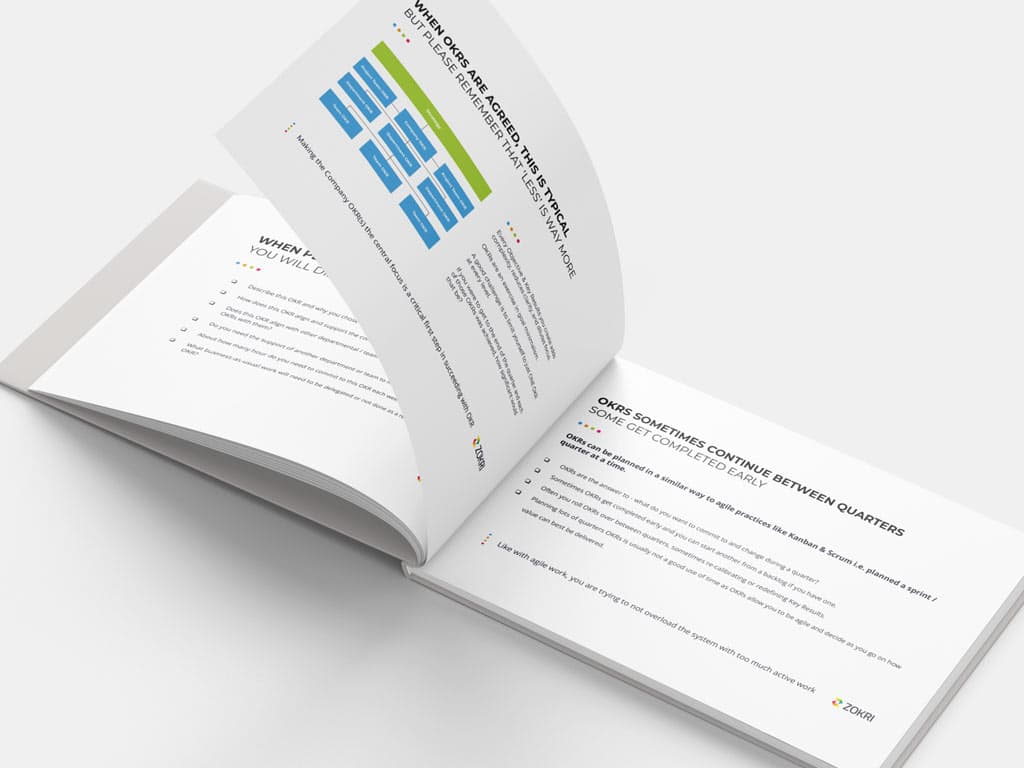As an OKR consultant I encounter the same problem time and again. Teams and managers understand too little WHAT they actually want to achieve. And translate what they do not fully understand into OKR. Garbage In, Garbage Out
That’s why I propose a simple OKR hack. The best way to jumpstart OKR: Forget about OKR when starting to work with OKR. Instead, first understand WHAT you want to achieve and what is important for your business. Then in the second step, give shape to your ambitions with the OKR method. The following three steps will help you in clarifying your context and thus provide an ideal preparation for working with OKR in the final fourth step.
Step 1: Reality Check
OKR (Objectives & Key Results) is a framework to develop your organisation and your business model in a goal-oriented way. This means that OKR is not about managing the status quo, but about initiating a desired business development. And development always means moving “away” from something “towards” a desired state. That is why in the first step you describe your context, the NOW or “current reality” so to speak.
The following questions help you to describe your current situation.
- What problems do you have with your current organisation, your current business model?
- How is the world around you, your customers and your company changing, with what megatrends are you currently being confronted?
- How do these trends affect your company, what opportunities but also threats arise from them?
- What are your strengths that you would like to develop further?
In this process, it is important that you maintain a very clear and honest view of your CURRENT situation, so that you can use it as a basis for developing a clear contrast to your desired future (TARGET). Unfortunately, I frequently see companies losing themselves in watered-down statements such as:
- “We want to change things, but we are doing fine.”
- “We just had the most successful year in the company’s history, so we are not forced to change anything, but …”
By saying this, they are actually claiming “We are doing so well that we shouldn’t change anything”. This takes the excitement out of any development. It’s like a boring movie in which the main character already has everything they need and is just having a nice sunbath for the entire rest of the movie.
Step 2: Sketch your desired Future
In the second step, you frame your desired future. Some companies can do this off the cuff, others know they need to change something but are not yet sure what the end point might be. However, this exercise is not so much about drawing a perfect picture. Rather, based on the answers and questions from the first step, it is about describing how your company and business model may be positioned in the future. The time period you choose does not matter, but you should move at least 3-5 years into the future.
In doing so, you describe how you envision your company, business model and organisation in the future. It is best to use present tense formulations and active instead of passive phrasing. Eventually, by drafting the “desired future” in this step on the basis of your “current reality” from step one, you have hopefully built up some excitement for change.
Step 3: What are your critical fields of action?
In the third step, you move to work level and invite people to work out critical working hypotheses. In other words, you identify issues which you will have to tackle so that a desired development can be set in motion at all. I recommend that you first only collect the issues and then group them into fields of action. If you have identified more than 3-5 fields of action, you may want to also prioritise your fields of action. These prioritised domains and fields of action are now embedded in the “desired future” and the “current reality”. This is the ideal prerequisite for you to finally start implementing the OKR method.
Step 4: Write your strategic OKRs
Based on the discussions so far, first define an appropriate duration for your OKR cycle at company level. A time span of 12-18 months is a good starting point. For each of your prioritised areas of action, you now set objectives and the associated key results. In doing so, you critically examine each OKR on the basis of whether it helps you to leave the “current reality” behind and take a step towards your “desired future”. This leaves you with thought-through strategic top level OKRs which provide the framework to successfully roll out the OKR programme in your organisation. Do not just formulate blurry strategic objectives, instead write a full OKR.
How to – Time, people und material
The questions outlined here should be discussed on a management and leadership level. Depending on the number of people involved, you will need nothing more than 1-4 days within a time frame of 1-3 months. There is a simple rule of thumb, the more unclear your strategy and the more people, the more time you need. The discussion should be moderated and accompanied by your OKR Master.
Conclusion – OKR won’t save you, if you don’t understand your strategy
Many organisations start working with OKR on the basis of a strategy that is too generic and unspecific. They use unclear terminology, proclaim goals that are too vague or interchangeable. These intermediate steps outlined here will help you and your organisation close these gaps and lay a successful framework for working with OKR.

DOWNLOAD FREE GUIDE TO STRATEGY DELIVERY USING OKRs
Learn how to write and manage OKRs. Discover how to combine Strategic Themes, OKRs, KPIs and Strategic Initiatives to achieve high levels of performance across teams.


